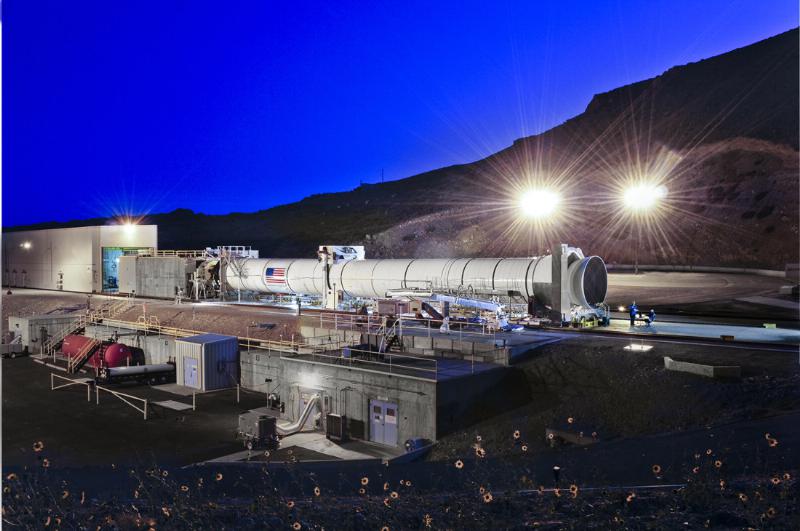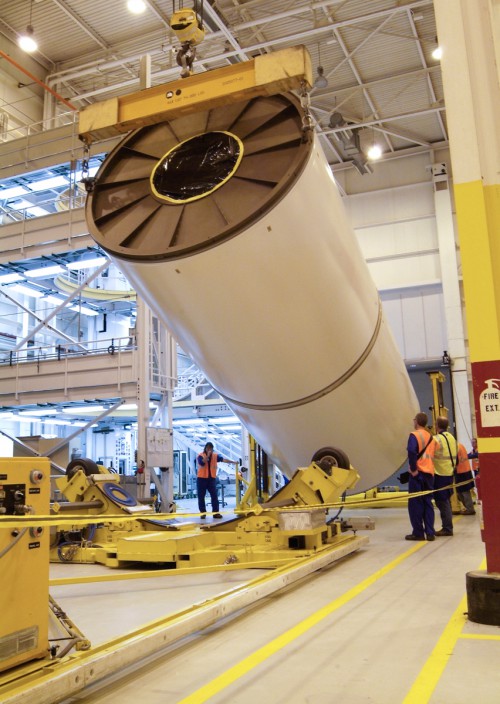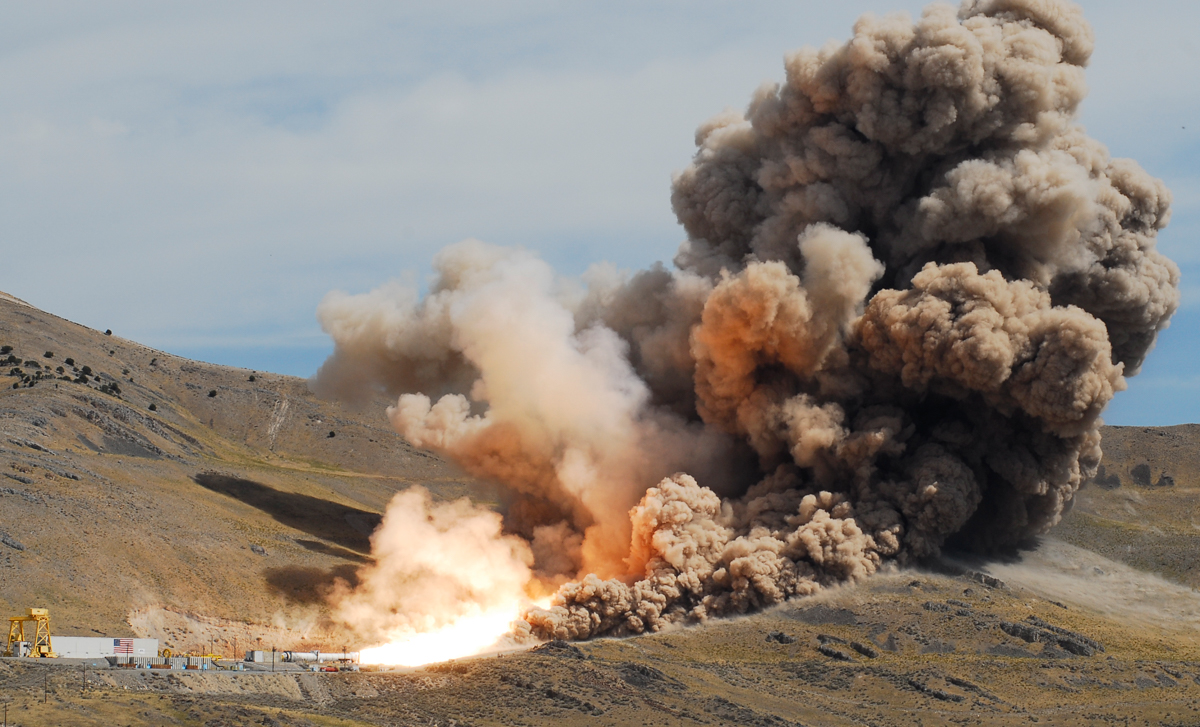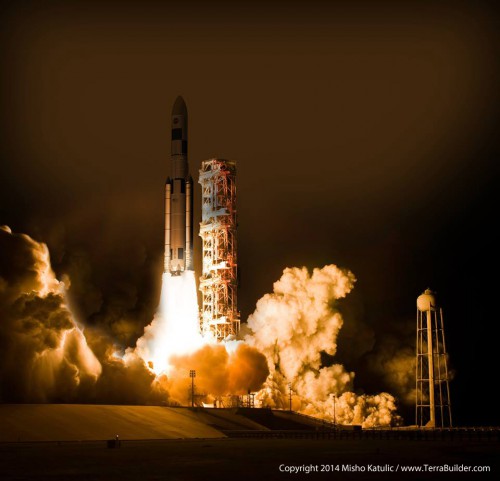
When NASA’s heavy-lift Space Launch System (SLS) rocket launches the agency’s Orion deep-space crew capsule for the first time in late 2018, it will mark the beginning of a new chapter in America’s human spaceflight efforts, aiming for destinations beyond low-Earth orbit (LEO) for the first time in four decades by employing the largest and most powerful launch vehicle mankind has ever created. The colossal 321-foot-tall SLS will thunder toward space on the power of four former (upgraded) liquid-fueled space shuttle RS-25 engines, but even with a combined thrust of nearly 2.5 million pounds those four engines alone won’t be enough to provide the 70-metric-ton (77-ton) lift capacity the initial SLS configuration promises.
The rocket needs more power at launch to make NASA’s ambitious deep-space human exploration plans a reality, and this Wednesday, at 9:30 a.m. MDT (11:30 a.m. EDT), Orbital ATK is expected to test fire the largest and most powerful solid rocket booster ever built to help get the job done.

Bookmark our “Launch and Events Tracker” to WATCH the test fire live!
The company’s 154-foot-tall, five-segment solid rocket booster (SRB) has been in development for years, having been initially designed to launch NASA’s Ares rockets for the agency’s cancelled Constellation program. The booster is similar to the four-segment SRBs that helped launch the space shuttle fleet, but it’s larger and incorporates several upgrades and improvements. Now, after a lengthy investigation and trouble-shooting effort to determine root cause(s) and corrective actions for the existence of small voids previously discovered between the propellant and outer casing of the booster’s aft segment, Orbital ATK is ready to move forward with their full-scale test fire of the company’s SLS booster test article, Qualification Motor-1 (QM-1).
“Years of extensive work and testing have gone into preparing us for this qualification test,” said Alex Priskos, manager of the SLS Boosters Office at NASA’s Marshall Space Flight Center. “We can’t stress enough what a big deal this is in preparing the rocket for flight.”
“Testing before flight is critical to ensure reliability and safety when launching crew into space,” said Charlie Precourt, vice president and general manager of the company’s Space Launch division. “The QM-1 static test is an important step in further qualifying this new five-segment solid rocket motor for the subsequent planned missions to send astronauts to deep space.”
Three fully developed, five-segment SRBs have been fired up on Orbital ATK’s Promontory, Utah, T-97 test stand since 2009, with the most recent having been conducted in 2011, and all performed fine. Those tests, known as the Development Motor test series (DM-1, DM-2, and DM-3), helped engineers measure the new SRB’s performance at low temperature, verify design requirements of new materials in the motor joints, and gather performance data about upgrades made to the booster since the shuttle program.
Once ignited the five-segment SLS booster will deliver an incredible 3.6 million pounds of thrust, which is equivalent to 22 million horsepower—each—and the SLS will employ two of the 1.6 million pound boosters (1.4 million is propellant) to help NASA’s future deep-space crew missions escape the pull of Earth’s gravity to reach destinations such as an asteroid and, eventually, Mars. The five-segment SLS boosters will burn for the same amount of time as the old shuttle boosters—two minutes—but they will provide 30 percent more power.

For Wednesday’s QM-1 test fire more than 500 instrumentation channels will be used to help evaluate over 100 defined test objectives, some of which are as follows:
- Hot conditioned to upper limit for propellant mean bulk temperature
- Ballistic performance data
- Nozzle vectoring parameters
- Insulation performance factors (asbestos-free design)
- Ablative nozzle erosion
- Vibration, acoustic, and heat flux data to support definition of environments
- Command and control using flight-like avionics subsystem
- Nozzle plug debris characterization
- Analysis of instrumentation data and post-test hardware evaluation used to show compliance to objectives
Daily countdown test runs have been conducted for the past couple weeks to verify all systems are ready for Wednesday’s QM-1 test fire. According to company spokesperson Kay Anderson, the dry runs went very smoothly and served their purpose, which was to find any bugs or discrepancies and resolve them long before test day.

To help put the power of Orbital ATK’s five-segment SRB into perspective, consider this: If the heat energy of the booster could be converted to electric power, the two SRBs firing for two minutes would produce 2.3 million kilowatt hours of power, enough to supply the entire power demand of over 92,000 homes for a full day.
QM-1 will support qualification of the booster design for performance at the highest end of the motor’s accepted propellant temperature range, some 90 degrees Fahrenheit. In order for engineers to specifically assess this the booster has been housed for some time inside a 100 degree Fahrenheit movable structure, conditioning QM-1 daily in order to reach a propellant mean bulk temperature of 90 (+/- 5) degrees Fahrenheit.
The “test window” is available until 2:00 p.m. MDT (4:00 p.m. EDT); if they cannot fire the booster by that time they will stand down for crew rest requirements and try again March 12, assuming the delay was something minor that would not require an extended delay (of course, that cannot be determined until it happens).
Once the test is complete, a post-fire disassembly inspection will be conducted. It will take approximately six weeks to disassemble and remove the QM-1 booster from the test stand, and detailed inspections will take another several months.
A second, low-temperature test (QM-2) is planned for early 2016 before the hardware testing to support qualification of the boosters will be complete, at which point they will then be ready to proceed toward the first flight of SLS, currently scheduled to fly on the Exploration Mission-1 (EM-1) in late 2018.
Orbital ATK has set up public viewing areas for the test fire, so anyone wanting to witness it in person is welcome to make their way to Promontory, Utah, to see another big milestone on the road toward the first launch of NASA’s SLS.
Want to keep up-to-date with all things space? Be sure to “Like” AmericaSpace on Facebook and follow us on Twitter: @AmericaSpace
Missions » SLS » Missions » SLS » QM-1 »




Awesome
“Once ignited the five-segment SLS booster will deliver an incredible 3.6 million pounds of thrust,-”
“-an important step in further qualifying this new five-segment solid rocket motor for the subsequent planned missions to send astronauts to deep space.”
THAT is what it’s all about: Human Space Flight Beyond Earth Orbit. The only problem is the lack of public support. HSF-BEO is very poorly funded compared to other government initiatives. Exciting new destinations holding the possibility of living oceans make Mars a poor “horizon goal” yet even the money for this supposedly “just close enough” trip is not forthcoming. The ugly truth being hid from the public is that space radiation makes nuclear propulsion a requirement to push a massive cosmic ray water shield. And the only place to economically acquire water shielding and assemble, test, and launch nuclear missions is the Moon.
When DOD programs like Ballistic Missile Defense, the V-22, F-35, LCS, and other highly criticized money holes are all added up, doubling the NASA HSF-BEO budget and accelerating SLS would be a drop in the bucket. In addition, dumping the entire NewSpace business plan by de-orbiting the ISS and bypassing LEO in favor of going back to the Moon would be the best course.
The billions in tax dollars and free NASA support disappearing into the rat hole of SpaceX and undercutting their competition would fund a lunar exploration program using the SLS. A successor to the SLS using 4 five-segment SRB’s could be flying in a decade.